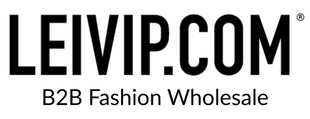The B2B Wholesale Cash Flow Trap
In today’s challenging economic environment, cash flow velocity is not just a metric—it is a matter of survival for every boutique retailer and small-to-medium enterprise. Unfortunately, the established, decade-old wholesale model is fundamentally flawed. Demanding massive pre-orders 6–9 months in advance, it forces retailers into a capital-freezing cycle, where substantial funds are locked away, exposed to market shifts and high Inventory Risk.
This capital-freezing cycle leaves retailers struggling to keep liquidity moving — until now.

Leivip is leading a necessary disruption. We introduce the Lean Sourcing strategy, built specifically around Ready-to-Ship Wholesale. Our promise is to revolutionize your procurement timeline, cutting the wait from months to mere weeks. This strategic shift facilitates an essential, measurable increase in your cash flow velocity. As a trusted Leivip fashion wholesale partner, we empower retailers across Europe through a multi-brand fashion wholesale platform designed for liquidity and agility.
The Traditional Wholesale Model: A Direct Threat to Retailer Viability
The long-term pre-order system is the ultimate drain on retailer liquidity. Consider the standard 6–9 month cycle:
- Month 1 (Payment): You commit and pay for merchandise based on a guess of next season’s trends. Your capital leaves your bank account.
- Months 2–6 (Waiting): Funds generate zero return—frozen.
- Months 7–9 (Sales): Goods finally arrive and sell—if the trend holds. Only now does your cash begin to return.
This creates a massive Funds Lag. Not only is working capital trapped, but the opportunity cost of missing immediate, high-margin buys compounds risk. This model suits large corporations with deep reserves—not agile, profit-sensitive boutiques.
Data-Proven Results: How High-Frequency, Low-Batch Buying Accelerates Cash Flow
+300% Cash Flow Velocity: The Power of Leivip’s LBHB Model
Case Study: Sarah’s Boutique (Abstracted Client)

Small, frequent purchases cycle capital back every few weeks, instead of locking it for months. This creates a virtuous loop of reinvestment and profit realization—the mechanism behind a ~300% improvement in cash flow velocity.
Data Statement: The purchase record above is authentic and derived entirely from real customer transaction data on the Leivip.com platform. Timestamp: Q3 2025. Verification available upon request.
Leivip’s Three Cash Flow Accelerators: Tools for Lean Sourcing
3.1 Accelerator #1: Ultimate Speed → Fastest Cash Realization
The time from payment to product on the shelf must be minimal. This is where Ready-to-Ship Wholesale is non-negotiable.
- Benefit: Working capital is only tied up for the short shipping window. Goods arrive quickly, enabling immediate sales and minimal opportunity cost.
- Proof Point: Our core promise is 48-Hour Shipping for eligible items — a guaranteed standard that returns control of your capital almost immediately. Logistics Policy
3.2 Accelerator #2: Flexible Low MOQ → Strategic Risk Diversification
Traditional high MOQ is a barrier for boutiques. Leivip champions the LBHB model by offering orders from just €100.
- Benefit: Spread risk across small transactions and test new styles from high-quality Italian brands with minimal exposure.
- Financial Impact: Maintain liquidity; scale only the proven winners.
3.3 Accelerator #3: Data-Informed Selection → Zeroing Out Dead Stock Risk
Prevent capital from turning into dead stock by procuring from current, verified market activity rather than guessing far-future trends.
- Benefit: Access high-demand, Ready-to-Ship collections with strong sell-through potential.
- Strategic Advantage: Explore Top Sellers & Ready-to-Ship curated by our internal market signals.
Strategic Implementation: The New Rules of Retail Procurement
- Adopt a Dynamic Budgeting Cycle: Allocate funds in smaller weekly or bi-weekly blocks to keep capital liquid for opportunistic buys.
- Use Ready-to-Ship for Core Assortment: Keep inventory lean and rotation fast via Multi Brand Ready-to-Ship.
- Test & Validate Constantly: Use low MOQ to trial experimental styles; reorder winners with 48-hour delivery.
- Prioritize Profit Over Bulk: Optimize for cash flow velocity, not just unit cost. Faster turns compound annual profit.
Join over 30,000 registered boutiques across Europe who already rely on Leivip’s multi-brand fashion wholesale platform to grow faster with flexible, ready-to-ship sourcing.
Seize Control of Your Retail Future
By embracing Leivip’s Lean Sourcing, you reject outdated financial burdens and eliminate capital freezing and inventory risk. Turn your procurement budget into a high-liquidity growth engine.










